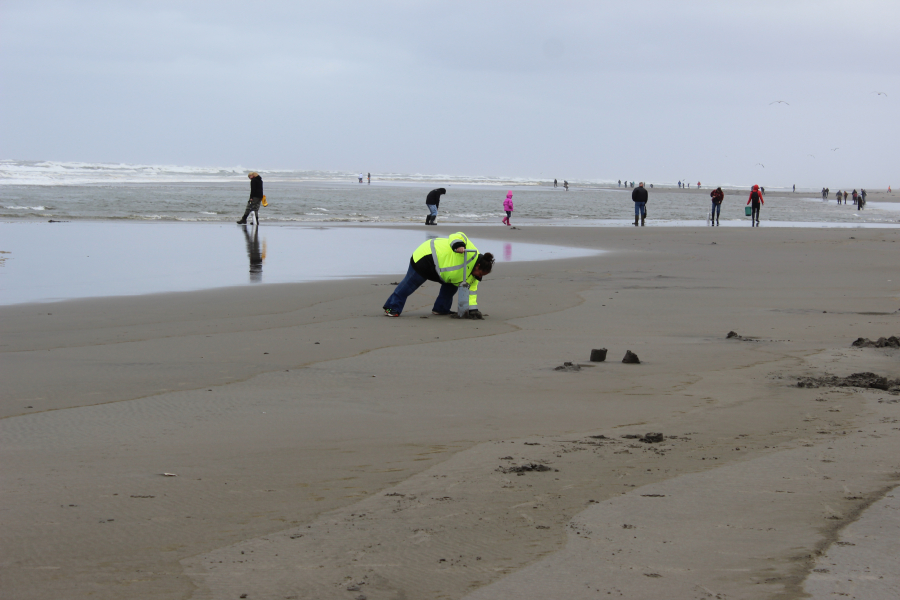The popular New Year’s Eve razor clam dig is scheduled to take place this year. The WDFW has also added a few extra digs after testing showed that clam abundance was high enough.
Prospects are good on the Long Beach Peninsula, but success will depend on a few factors including surf, weather, and location.
One pattern has emerged during the November and early December digs: Go north.
“It’s a little unusual,” said Dan Ayers, the coastal shellfish manager for the WDFW, “It’s been much better to the north. It’s much slower down by the town of Long Beach.”
Surveys for clam numbers by the WDFW have shown a scarcity of razors to the south, but there are very good numbers in the northern 1/3 of the peninsula. One possible culprit may have been the high flows out of the Columbia River that lasted well into June of 2017.
According to Ayers, the fresh water plume flushed out of the Columbia moves mostly north with the ocean currents. When this happened salinity levels along the lower peninsula dropped and were about half of what they normally are. He reports that clams don’t do as well when the salinity is that low.
The beaches to the north were not as affected as much. Ayers said clammers were doing very well up there.
Frank Gaast of Camas and his daughter Patricia Telio of Vancouver would agree. They pulled limits off the beach near Oysterville on Dec. 4. They had arrived about two hours before the tide bottomed out, and were leaving about a half hour later.
“I don’t even like razor clams,” admitted Telio, “but I like digging them with my Dad. It’s fun!”
“We went out in November and got our limits then, too,” added Gaast.
Sue Baker of Vancouver and her friend also had their limits. She offered some very good advice. “Don’t go out by the edge of the water,” she said. “Stay in closer.” According to her the best action was being found along the flats not too far out.
A short excursion proved this to be true. It took very little time to dig a limit on the near shore flats.
Nighttime clamming
During the winter the best tides are in the evening and at night. Clammers hunt their quarry with lanterns and high power flashlights searching for clam “shows”. Once one is found a clammer must dig fast because razor clams can dig deeper very quickly and escape.
A razor clam show can best be described as a small circular dimple in the sand. With just a little experience clam hunters can spot them very easily.
Either a clam gun or a clamming shovel is used. The guns use suction to pull up the razors, and the shovels are used to excavate a hole quickly that can then be dug deeper by hand. The hand method allows the hunter to pull the clam without damaging it, something the clam guns sometimes do.
Fifteen clams are allowed per day. Each person must dig their own clams and retain them separately. The first 15 clams dug must be kept, no matter the size.
Of the four-day season in early December clamming was best during the last two days. According to Ayers the high surf during the first two nights kept the harvest low.
Razor Clams don’t like to get pounded so they stay deep and rarely show when the surf is high. Weather also plays a roll. If it is raining hard the shows are quickly washed away.
Safety in numbers
Clamming at night can be dangerous especially when the surf is high. Each year a few clam hunters are swept off their feet by waves driven by big surf. It is always a good idea to go clamming with friends, and never turn your back on the sea.
It is also easy to get disoriented when clamming on a flat beach at night, especially since a clam hunters eyes are on the sand at their feet. The steady stream of clamming trucks driving up and down the beach will help orient you, but be aware of where you are at all times.
Lanterns seem to do better than flashlights, but everyone has a preference and if it works for you, do it.
If you are new to this sport try to find an experienced clam hunter to take you out the first time.
The New Year’s Eve dig will take place in the evening. The WDFW has tested the clams and determined that they are safe to eat.
Always check the WDFW website before clamming to make sure it is open, and then check the weather, tides, and surf predictions online. If the surf is going to run 10 feet or higher, stay home.




